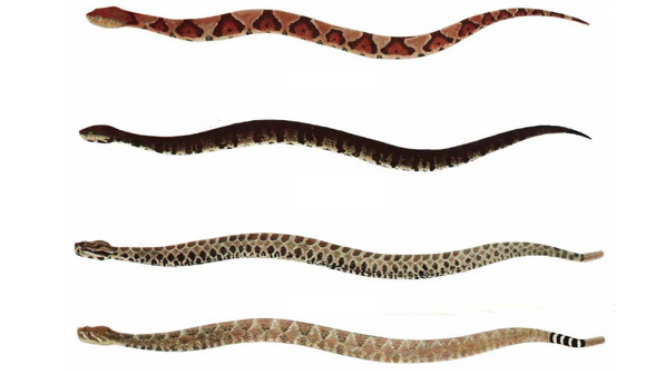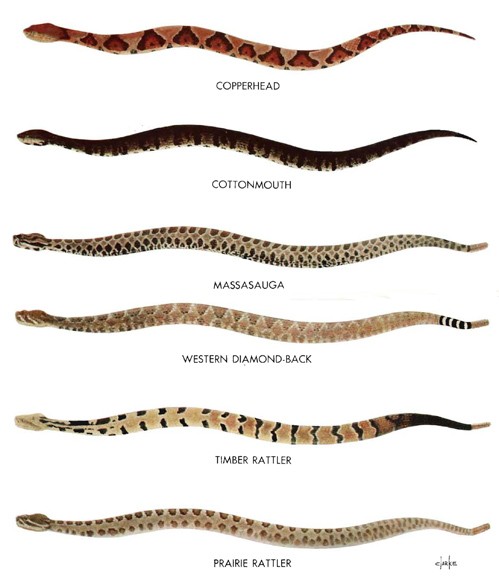A quick way to make a day in the wilderness, camping trip or survival situation dangerous is to encounter a poisonous snake.
Almost every region of the country has at least one type of poisonous snake – even New England has two types, although encountering them in the wild is very rare.
HOW TO TELL A POISONOUS FROM A NON-POISONOUS SNAKE
The features given here apply only to Kansas snakes and may not be applicable elsewhere. Even in Kansas, there are some non-poisonous snakes which exhibit either the tail or eye characteristics given for poisonous snakes, but none have the pit. It probably need not be pointed out that these features can be seen only when the snake can be examined closely. Certainly, every snake should not be picked up to look for these characteristics! A warning is necessary at this point – reflex action can cause an apparently “dead” snake to bite, so do not handle “dead” snakes with the hands; use a stick. The best way to be able to identify a poisonous snake is to know all of the venomous snakes of your region by sight. Color and pattern are distinctive and are easily learned.
COPPERHEAD (Agkistrodon contortrix). Length usually 2-3 feet. Common where it occurs, the copperhead is probably the most abundant poisonous snake in eastern Kansas. It is most frequently found in the vicinity of rocky ledges in oak-hickory-walnut woods, but it ranges widely, so that individuals may be found in almost any habitat during summer months. Although generally nocturnal during most of its active season, its habit of lying in the open during the daytime among dried leaves in patches of sunlight and shadow causes the pattern to blend perfectly with the background. Any hiker through this habitat should be alert. Because of the rather small size, usually inoffensive disposition, and the low toxicity of its venom this snake should be placed on the nonfatal list for adults. Elderly persons, those in poor health, or small children could find the copperhead bite fatal, however.
A subspecies of the copperhead occurs along the southern border of Kansas. In this form, the crossbands are wider along the mid-line than the more northern variety.
Young copperheads have a sulfur-yellow tail. This color is lost as the snake matures. It is thought that this contrasting tail color is used as a lure to bring prey within striking distance of the small snake. The young are born in August or September. There may be from two to ten in a litter.
COTTONMOUTH (Agkistrodon piscivorus). Length 3-4 feet. The poisonous water moccasin has been taken only once in Kansas. This was on the Neosho River in Labette County at the Cherokee County line.
It is on the basis of this single specimen that it is counted as one of the snakes of Kansas! The many general reports of water moccasins in Kansas refer to the mistaken identification of the harmless water snakes that are common throughout most of the state (see page 12). Young cottonmouths are patterned quite like a wide-banded copperhead, but the colors are not so reddish. These snakes are always found in the vicinity of water. When approached they quite often hold their ground and open their mouths widely, revealing the white lining of the mouth, a habit which gives them their common name. This heavybodied snake is dangerously poisonous and, contrary to popular belief, can bite underwater.
Whereas the copperhead is a rather mild-mannered snake, the cottonmouth has a vicious disposition.
Although nocturnal, it likes to sun-bathe, and it is frequently seen basking along shorelines, stretched out on low branches or upon the bank. Where this snake occurs, it is usually common.
Generally, eight or nine young are born in August or September, although the number of young may range from five to fifteen. Like the copperhead, the young have a yellow tail tip.
MASSASAUGA (Sistrurus catenatus). Length 24-27 inches. This snake belongs to a group of small rattlesnakes called “ground” or “pygmy” rattlers, which are differentiated from the larger rattlers by having paired scales on top of the head, as have the copperhead, cottonmouth, and non-poisonous snakes. The massasauga occurs in open fields and rocky outcroppings. It is particularly common in the Flint Hills. This is the “prairie rattler” of eastern Kansas, often found under hay bales in fields. Its food consists primarily of small rodents. The small size and usually docile disposition of this snake tend to place it upon the nondangerous list, but its venom is extremely toxic, and any bite from a poisonous snake is dangerous. When aroused, these small snakes strike with a fury not seen in the larger snakes.
The rattling of this small snake is hardly louder than the buzz of a grasshopper.
The name “massasauga” is an Indian term, meaning ‘”swamp dweller,” a habitat preference which is evidenced more in the states to the northeast of Kansas.
Two subspecies occur in Kansas. In the eastern part of the state is the form that occurs eastward of Kansas, characterized by the dark belly; the lighter-bellied form extends westward from eastern Kansas into states to the southwest.
About eight or nine young are born, usually in August or September.
WESTERN DIAMOND-BACKED RATTLESNAKE (Crotalus atrox). Length 4-5 feet, although some are larger. In the United States, probably more deaths are caused by this snake than by any other. A combination of large size, wide distribution, abundance, and touchy temperament give this distinction to this snake. It is hardly a member of the Kansas snake fauna, having been found only twice in the state, both times in the southeastern corner. It should occur, although presently unrecorded, in south-central Kansas along the Oklahoma line. It is rather common in Oklahoma, just south of this region. The diamond-back prefers dry open plains and canyons, where it feeds upon small rodents, young rabbits, and occasionally, birds. The ground color varies somewhat from buff to gray; the snake generally has a faded appearance. The black and white tail bands are distinctive.
About ten young are born in late summer or early fall. Larger litters have been recorded. The young are fully capable of inflicting a dangerous bite as soon as they are born – and quite willing to do so!
In northern Oklahoma, an annual rattlesnake roundup is held, in which several hundred diamond-backs are captured. These are processed for their venom, from which antitoxin is made. Some of the rattlesnakes are cooked and their steaks used in a banquet. The meat is firm and quite tasty!
TIMBER RATTLESNAKE (Crotalus horridus). Length 3-4 feet, occasionally longer. The timber rattler occurs only in eastern Kansas and is only locally common, at scattered localities. It prefers the deciduous forest where Limestone rock outcrops as ledges, but may wander into cultivated fields and open areas during late spring and summer. The food consists primarily of small rodents and young rabbits. Ordinarily, it is a mild-mannered snake, one which will seek to escape direct contact with man, but its size and habit of living close to human habitations necessitate considering this rattler dangerous.
Ground color may vary from a light gray to yellow, with the black chevron-shaped blotches of the back uniting with lateral blotches to form crossbands. Another common name for the timber rattler is banded rattlesnake. Some individuals may be almost all black. The tail is characteristically velvet black in adults; banded in young.
During the spring and summer the timber rattler is quite often encountered crossing roads, where its large size and slow movement often make it a victim of modern transportation.
The timber rattler has a habit of frequently spending daylight time just beneath the edge of overhanging rocks. A hiker should always look beneath any rocks of this sort before using the rock as a resting place.
PRAIRIE RATTLESNAKE (Crotalus viridis). Length 3-4 feet. This rattlesnake is common in western Kansas, where it frequents rocky open regions, grassy prairies, and agricultural areas. In eastern Kansas it has been found only in the Pittsburg vicinity, and any “prairie rattler” east of Wichita or Manhattan is usually the massasauga. The habit of denning in large groups is well-known. Several hundred have been found in hibernation in a single den. The food of the prairie rattler is warm-blooded, mostly rodents and small rabbits. It appears to be active in the daytime, whereas the other poisonous snakes are mainly nocturnal. The ground color varies from a light gray to green, and the pattern of dorsal blotches with alternating rows of lateral blotches may cause it to be confused with the smaller massasauga, but the scales on top of the head are all small on the prairie rattler, whereas paired plates are present on the massasauga (see diagram, page 6).
Young are born in late summer or early fall. Usually nine to twelve constitute a litter. As few as five and mas (sic) many as seventeen have been recorded, however.
It has been found that anyone female prairie rattler gives birth to a litter of young every other year.
These young are generally about twelve inches in length.
This snake has a wide range over western United States, where it is probably the most common rattlesnake. It is frequently found in prairie dog villages. The burrows of these animals are utilized as shelter and the young are used as food items.
While most snakes are not poisonous and the majority avoid human contact as much as possible, there are venomous snakes in virtually every region of the country and Canada.
This covered the most common venomous snakes found in the largest swath of the US, but you should check with your state's Fish and Game Department to get a briefing on what, if any poisonous snakes lurk in the place you are living, hiking or camping.
For more information on poisonous snakes, including what to do if you are bitten, please visit Emporia State University.


Kill them all.
You would think that the expert writing this article would know that snakes are venomous not poisonous.
I agree, it gets under my skin too..venomous people. Not Poisonous!
Rat snake on top,
Copperhead on bottom?
If your unsure then leave them be. Test passed.
I’m not going in to this article but the snakes I can see is a copper head a cottonmouth the other two have rattlers that’s enough to tell me to steal f*** away from all four that I can see
Copperhead water moccasin timber rattlesnake and Diamondback
No Gary Ford…it’s not…u could drink venom and be fine..
Dumbass
Copperhead, Cottonmouth, Massagua rattler, Diamondback rattler
Get a fucking life AJ……
I respect Nature , have seen all these snakes at one time or another , Leave them alone and they leave you alone , antagonize them at your own risk !!!